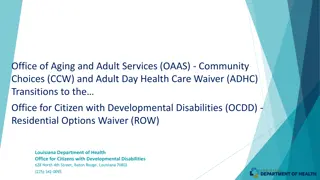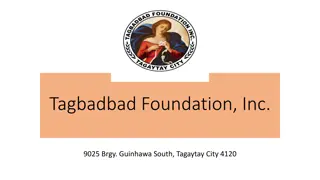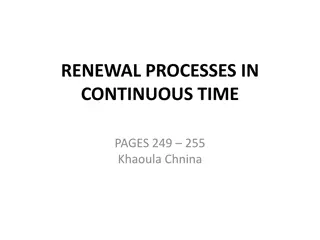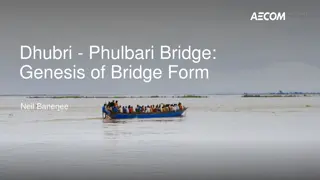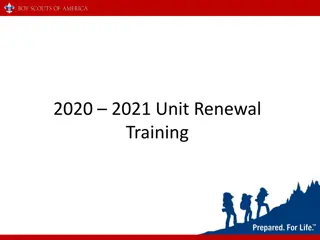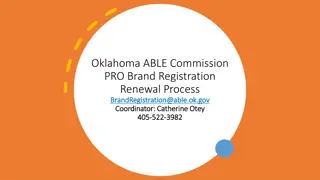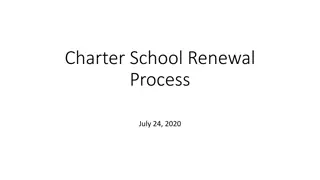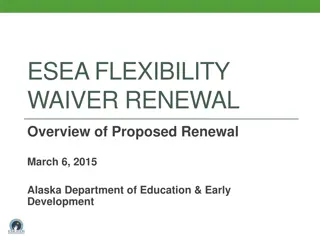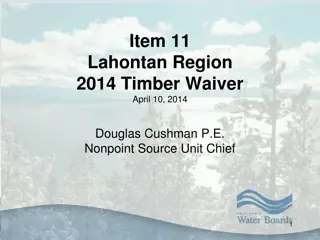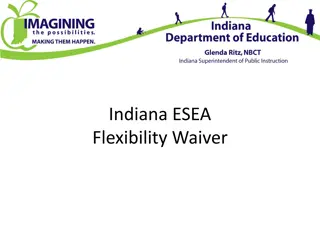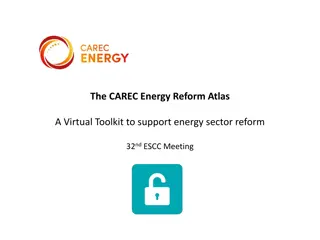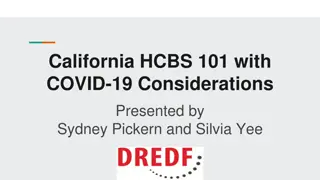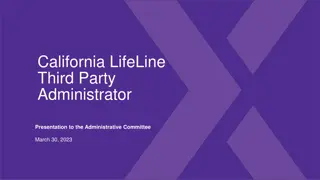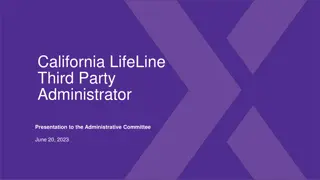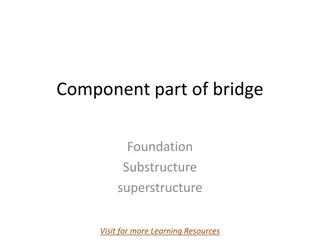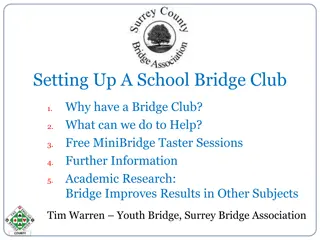Overview of California's Bridge to Reform Waiver Renewal
California's Bridge to Reform waiver renewal process involves requesting flexibility to design healthcare demonstration projects aligning with Medicaid program objectives. The current waiver, effective from 2010-2015, focuses on key goals like strengthening the health care safety net and promoting community-based care. Successes include various health initiatives such as Low Income Health Program, Delivery System Reform Incentive Pool, and expansion of services for different demographics like seniors and children. Renewal requests must be budget-neutral and submitted to CMS six months before the current demonstration ends.
Download Presentation

Please find below an Image/Link to download the presentation.
The content on the website is provided AS IS for your information and personal use only. It may not be sold, licensed, or shared on other websites without obtaining consent from the author.If you encounter any issues during the download, it is possible that the publisher has removed the file from their server.
You are allowed to download the files provided on this website for personal or commercial use, subject to the condition that they are used lawfully. All files are the property of their respective owners.
The content on the website is provided AS IS for your information and personal use only. It may not be sold, licensed, or shared on other websites without obtaining consent from the author.
E N D
Presentation Transcript
Section 1115 Waiver Renewal Housing/Shelter Expert Work Group Framing Our Discussion John Shen Chief, Long-Term Care Division, Health Care Programs Department of Health Care Services November 4, 2014
1115 Waivers Allow states flexibility to design demonstration projects that promote the objectives of the Medicaid program Demonstrations are typically approved for five years; states may submit request for renewal for 3 - 5 years Must be budget neutral 2
Bridge to Reform Waiver 2010-2015 Current Waiver demonstration sunsets October 31, 2015 Waiver renewal request must be submitted to the Centers for Medicare and Medicaid Services (CMS) at lest 6 months before the end of the current Demonstration 4
Bridge to Reform Waiver 2010 - 2015 Six Primary Goals Strengthen California s health care safety net Maximize opportunities to reduce the number of uninsured individuals Optimize opportunities to increase federal financial participation and maximize financial resources to address uncompensated care Promote long-term, efficient, and effective use of state and local funds Improve health care quality and outcomes Promote home-and community-based care 5
Successes of Bridge to Reform Low Income Health Program (LIHP) Delivery System Reform Incentive Pool (DSRIP) + Category 5 HIV Transition Projects Transition of Seniors and Persons with Disabilities (SPDs) into Mandatory Managed Care California Children s Services (CCS) Pilots Health Families Program (HFP) Transition Rural Managed Care Expansion Indian Health Services Uncompensated Care claiming ACA Optional Medi-Cal Expansion Community-Based Adult Services (CBAS) Integration of Outpatient Mental Health Services Safety Net Care Pool / Designated State Health Programs Coordinated Care Initiative (CCI) Organized Delivery System Waiver for the Drug Medi-Cal (DMC) Program (pending) Full Scope Medi-Cal for Pregnant Women 109-138% FPL (pending) 6
2015 Waiver Renewal Initial Concepts 7
Purpose of 1115 Waiver Renewal Shared Goals with CMS To further delivery of high quality and cost efficient care for our beneficiaries To ensure long-term viability of the delivery system post-ACA expansion To continue California s momentum and successes in innovation achieved under the Bridge to Reform Waiver 8
Objectives Strengthen primary care delivery and access Avoid unnecessary institutionalization and services by building the foundation for an integrated health care delivery system that incentivizes quality and efficiency Address social determinants of health Use California s sophisticated Medicaid program as an incubator to test innovative approaches to whole-person care 9
Federal/ State Initial Waiver Concepts Shared Savings Workforce Development 8 Groups Payment/ Delivery Reform Incentive Payments Initial Waiver Concepts Shelter for Vulnerable Populations Safety Net Payment Reforms FQHC Payment/ Delivery Reform CCS Program Redesign Successor DSRIP 10
Federal/State Shared Savings Under the Waiver, a per-beneficiary-per-year cost amount would be established based on predicted costs for those beneficiaries absent the waiver The state would retain federal funding for the difference between actual expenditures and pre-established per beneficiary amounts The savings serve as key component that will allow CA to implement many of the other waiver initiatives Concept is not a per-capita cap that limits entitlement spending; any excess spending over the anticipated per-beneficiary cost would count against budget neutrality margin Related Objective: Use California s sophisticated Medicaid Program as an incubator to test innovative approaches to whole-person care 11
Medicaid-Funded Shelter Potential to test ways in which Medicaid-funded shelter can contribute to better health outcomes and reduced total cost of care for beneficiaries Ideas, such as subsidized housing, can support the goal of a whole-person approach to care for vulnerable populations Related Objective: Address social determinants of health Related Objective: Use California s sophisticated Medicaid Program as an incubator to test innovative approaches to whole-person care 12
Who would be the potential target populations? Two populations are of particular interest to DHCS Homeless individuals who utilize local ER and hospitals Nursing Facility residents who can be cared for in community settings. They may include those who were homeless prior to placement or lost their home upon extended stay. Both populations share some common characteristics They rely on SSI as primary source of income; They have some combination of chronic conditions, disabilities, mental illness and/or substance abuse; They need substantial amount of care management, habilitation, primary care intervention, and ongoing intervention from various service providers. Within these two populations, there are distinct needs as defined by their age, gender, clinical profiles, and service needs. 13
What is Medicaid funded Shelter? Shelter : Rationale that Medicaid needs to be involved in addition to existing housing financing infrastructure Funding of Shelter Capital for new buildings; Funding in the form of rental subsidies or operational funding; and/or Shelter based services DHCS is interested in how funding of the subsidies and services would stimulate developer interests and access to capital for buildings 14
What would be the funding levels and arrangements? Funding level for shelter units Guidelines for developing level of funding for rental subsidies or housing operational subsidies Guidelines on transitional versus permanent ; congregate versus community integrated or other types of shelter Roles of DSRIP and managed care plan Funding for shelter based services Guidelines on defining intensive care management and habilitative services; Inclusion of other Medicaid covered or uncovered services Guideline on Provider-Housing partnership 15
Options, scale, feasibility, cost benefits? Identification of options Scale and selection of geographical locations for pilots Feasibility Medicaid laws and regulations and CMS financial participation; Housing developer/operator interest; Provider and managed care plan interest and readiness; federal, state and local laws and regulations related to funding and operation of affordable housing. Anticipated outcomes and cost benefits Evaluation 16
Stakeholder Process Stakeholder Process 17
Stakeholder Engagement Federal-State Shared Savings One all-day stakeholder meeting for the Department to present the savings model and solicit input from a broad, impacted stakeholder group 18
Stakeholder Engagement Medicaid-Funded Shelter Four targeted workgroup sessions Meeting 1: Kick-off to establish evidence, best practices, other states experiences Meetings 2-4: identify demonstration options potentially focusing on different target populations 19
Foundation Support Stakeholder workgroup efforts DHCS is seeking funding support for stakeholder process and technical assistance from Technical assistance on concept development including linkage to subject matter experts The Blue Shield of California Foundation, the California Endowment, and the California Health Care Foundation Development of Special Terms and Conditions (STCs) 20
Stakeholder Process: Timing July 25, 2014: Webinar on initial DHCS concept paper Solicit input on Waiver concepts and stakeholder process Summer 2014 Stakeholder discussions and concept development Fall/ Winter 2014 Submission of Waiver renewal to CMS anticipated for February 2015 Winter / Spring 2015 Development of Special Terms and Conditions (CMS) Spring/ Fall 2015 21
Questions / Comments: WaiverRenewal@dhcs.ca.gov 22



